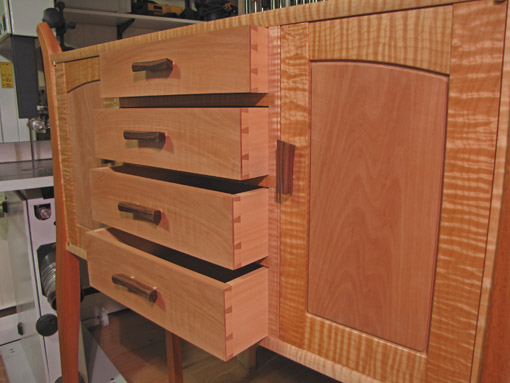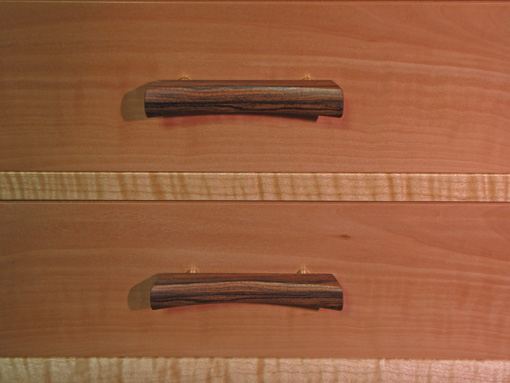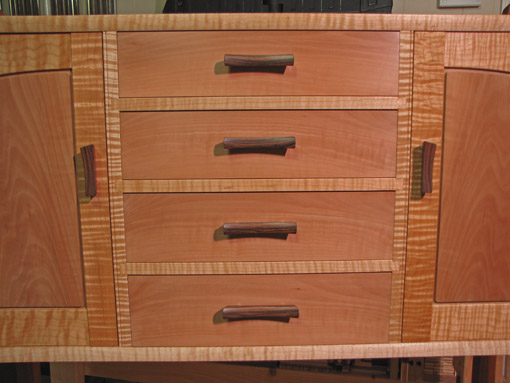
Making a drawer handle is a fun opportunity for creativity, but it ought not make a dissociated statement of its own. The handle should be consistent with the design of the whole piece while providing an interesting accent. I like a pull that is inviting to gently grab, yet is sturdy. For contemporary work with graduated-size drawers, commensurately graduated handle sizes may be a nice touch. I usually choose dark, dense, exotic woods for handles.

As I stated in the first installment of this series: “This is not the only way to make fancy drawers, nor do I propose it as the “best” way because that judgement depends on function and aesthetics which are ultimately the provinces of each craftsman for each project.”
I think the mystique surrounding drawer making is exceeded in woodworking only by finishing and chair making. I suggest forget that cloud of doubt. Crafting a nice drawer shares principles common to all woodworking:
- understand the logic of the process
- be exact, or perhaps more realistically, stay on the correct side of tolerance in the critical parts
- try to be at ease in your work.
Believe me, these drawers are not perfect; no one’s are! I do, however, try to work at a level where I can enjoy the process and the product, and forgive little imperfections.
I wish you enjoyment and success in your woodworking.



This was realy enjoyable series on drawers and the final piece look great from what I can see! thank you for your blog!
Best regard.
David
You’re most welcome, David, and thanks for reading. I hope the drawer series has been useful.
Rob
I’m making a small hall table with two drawers and have applied your approach to the process. I’ve make OK drawers before, but your advice has allowed me to move to a higher level of quality and fit. Thanks!
Stan, that’s great! And just the sort of thing that I hoped for in writing the series.
Rob
An excellent and most-informative series, Rob. Just curious, when you finish the outside of the drawer front after assembly do you also finish the top and bottom edges of the front?
I’ve done this but it invites stain getting where you don’t want it. In the future I think I’ll finish the top and botton front edges the same as the drawer sides, in my case shellac, and not stain them.
Please keep sharing your experience.
Gene
Gene,
I used water based poly-acrylic on the pear because it gives almost no color change. Oil and/or varnish gives pear an unpleasant greasy appearance in my opinion. All faces and edges of the pear drawer fronts are finished with this, lightly on the top and bottom edges.
The end grain sides of the drawer fronts have a minimal wipe of finish on them. This ends in a neat line, which is barely visible, along the wide ends of the dovetail pins. The rest of the outsides of the side pieces are finished only with a light waxing. I would not put a film finish (such as shellac) on the outsides of the side pieces.
I suggest use tape to mask off borders that you don’t want finish to cross. 3M #2090 or 2080 are good (the latter is less sticky and a bit easier to use) and 3M “Scotch” #2040 is solvent resistant if you need that.
I hope this helps.
Rob